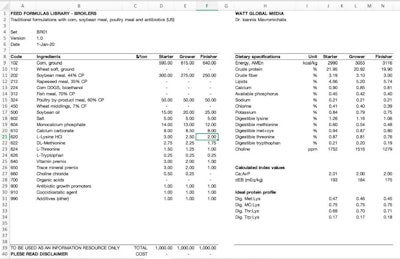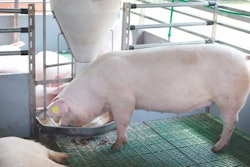
Even though a formula might appear feasible, a reality check should be performed.
I scripted my first code in 1989 as a freshman. No, my major was not computer science. I was in animal science, but I loved computers and programming.
I used a blueprint from IBM on least-cost solution coding and modified it to formulate feeds for broilers. It was not for commercial use because everything needed to be inside the coding; there was no user-friendly interface. I remember the person responsible for handling my run-exec commands upstairs was rather unfriendly after so many requests. The whole experience taught me two things: least-cost formulation is easy – only a page or two of programming code, and that all the money is on the interface.
At the next opportunity, I moved on. I was lucky enough to encounter a feed formulation program with a very user-friendly interface in my later years as an undergraduate student. It was a donation from the American Soybean Association (ASA) to the university I was attending. It was a simple piece of software, just right for a student, and I am still grateful to the ASA. Unfortunately, those responsible for the software were too busy with other projects. So, I left, unhappy about the whole affair.
Moving on to the U.S. and Kansas State University: My mentor, Dr. Joe Hancock, gave me full access to Brill software. It was like a door to heaven suddenly opened. It was an MS-DOS program, and it was the fastest software I have yet to encounter. No mouse, just clicks, and F1-F12 commands. It worked like a charm, and I must have spent countless hours formulating feeds for no other reason than fun and learning. A big thank-you is owed to Mr. Brill for his brilliant work of art. His later MS Windows versions never thrilled me as much as that MS-DOS version.
I kept using the same software at the University of Illinois, although my mentor there, Dr. Dave Baker, insisted I also learn how to formulate feeds by hand. In the meantime, I got to know another well-known package, Bestmix. That was used for feed mill operations, so I got to learn new capabilities, and that was yet another frontier to cross. About that time, everything had changed to MS-Windows, and now the mouse made things slower as you had to click, type a number, hit enter, and repeat. It still works like that in every program I have encountered.
As a field nutritionist for Provimi in the U.S., I had the privilege of working with a costly program, that of FORMAT, which was so elaborate I had to employ the services of a very skillful nutrition assistant to handle everyday chores. She was more patient than I deserved because I was and remain very fussy when it comes to formulating. Thankfully, my boss, Dr. Ken Bryant, was worse than I on this, so I got to learn even more from both of them about formulating feeds.
 MS Excel screenshot (Courtesy Ioannis Mavromichalis)
MS Excel screenshot (Courtesy Ioannis Mavromichalis)Since 2008, as a consultant now, I have been working with my own MS Excel-based program using the Solver add-on (now part of MS Excel). As I knew a few things about programming, I developed macro commands to handle the ingredient database and store/retrieve solved solutions. I even managed to extract a premix and reformulate using a concentrate – all with the click of a few buttons (after countless hours of coding, of course).
Then, the programming language changed, or the newer versions of MS Excel become incompatible (probably both), and I lost all my elaborate coding. There was no way I would repeat all this work, so I ended up with a simple solution: A new spreadsheet for each new customer, but that had some extra work required to keep each ingredient database updated. Those professionals in the formulation department know the drama involved when you have to handle multiple clients with more than one plant, different nutrient matrices, price lists, and so on. Thus, I had to have a new formulation assistant to handle everyday formulation work.
In the meantime, I got to know new commercial software on behalf of my customers, ranging from free to download to super-cryptic, requiring a dongle, to cloud-based services. Some had real problems; all had something positive about them. Some were too expensive for me (the better ones), others were not fit for a consulting job, others again were abandoned by their developers. Most simply crashed too often for my liking. So, although I often had to evaluate and recommend to my customers the right software for their work, I kept my good old MS Excel-based least-cost formulation program. I must admit there was an element of personal pride involved in having developed my own solution to my own problem. In every training session I do, I still start with that spreadsheet to show that formulation itself is not magic. It just needs knowledge and nimble fingers to keep trying when you end with an infeasible solution.
 Allix3 screenshot (Courtesy Ioannis Mavromichalis)
Allix3 screenshot (Courtesy Ioannis Mavromichalis)Last year, I clicked on a web banner, and I ended up getting a demonstration session to a program I ended up acquiring. It was Allix3 from A-Systems in France. It impressed me because it was affordable, user-friendly and flexible, without having too many whistles and bells if you did not want them, and I did not want them. So, the version I got gave me all I needed to the point I consented to transfer some of my work from MS Excel to Allix3. I am still learning it, but my nutrition assistant is already sold on it.
Consult our Animal Feed Formulations Library here.
















